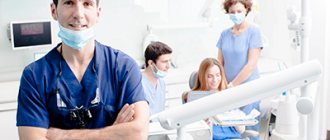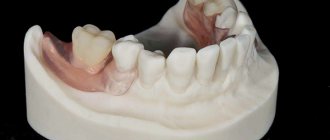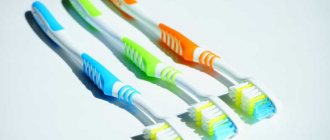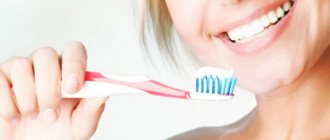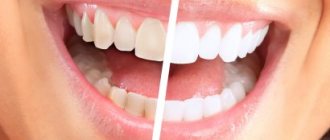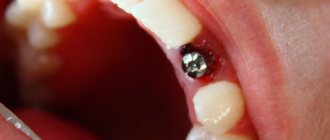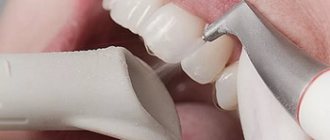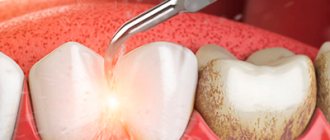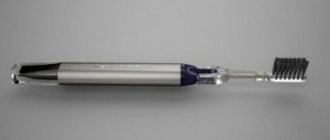Dentists recommend spending 3 minutes or more brushing your teeth. You need to brush with sweeping movements from the gums up, then go through the interdental spaces with dental floss and season everything with mouthwash. The technology is cool, but divorced from life. After a day at work and an evening with the child, I would like to find the strength to wave a brush in my mouth for a minute before falling on the bed. The floss and mouthwash will last until the weekend.
Cleaning on the run is like having lunch on the run: you seem to have eaten, but there is little benefit. As a result, the teeth become covered with soft plaque and then with stone. Next in line are caries, problem gums and regular, expensive appointments with the dentist. Professional cleaning of the oral cavity is not an excess or a whim of the rich, but a necessity for those who are categorically against false teeth in old age. You need to have your teeth brushed by a hygienist once every six months, then as recommended. The latest innovation in this area - laser teeth cleaning - can surprise and delight.
Clinical trials have recognized laser as safe teeth whitening in dentistry. Laser cleaning is performed for patients with weak enamel and increased sensitivity of teeth. A laser, unlike ultrasound, cleans without direct contact and removes deposits of any hardness. Laser radiation is harmful to oral microorganisms. Thanks to this, inflammation is eliminated, the enamel is strengthened, and the gums stop bleeding.
A pleasant bonus of laser cleaning is teeth whitening by several shades. With careful care and avoidance of coffee and cigarettes, the effect can last for 2-3 years. A plus for those who still have used Soviet drilling machines and are terrified of the buzzing sound will be the noiselessness of laser cleaning.
Working principle of an ultrasonic toothbrush
When using an ultrasonic brush, teeth are cleaned using both bristles and high-frequency waves. The bristles clean the enamel from surface contaminants, just like a regular toothbrush. You just don’t need to put pressure on your teeth or rub them with the device. It is necessary to move the head from one part of the jaw to another, lingering in each area for a few seconds.
Ultrasonic waves created by the device penetrate deep into deposits, destroying them from the inside. They are separated from the enamel and washed out of the mouth. At the same time, the mouth is cleansed of germs. You may feel warm while cleaning. As a result of an increase in temperature by 1°, blood flow in soft tissues is stimulated, as with a light massage, which reduces their sensitivity and prevents the development of gingivitis. In addition, calcium and fluoride ions are released from toothpaste, which strengthen the enamel.
Using an ultrasonic brush, you can maintain oral hygiene without resorting to other means: balms, dental floss, etc.
Advantages
Removing tartar helps prevent serious dental diseases that affect not only the tooth, but also the gums.
Professional cleaning can also be done using other methods. However, in addition to the listed advantages, the laser method has the following advantages:
- the ability to clean enamel even from the hardest deposits;
- cleaning stone from hard-to-reach places (including subgingival pockets);
- strengthening enamel;
- preventive action;
- duration of retention of the result;
- no discomfort during the procedure;
- enamel lightening up to 3 tones;
- polishing the surface being treated.
The only drawback that laser teeth cleaning method has is the price. The cost of such a procedure is quite high. However, if we take into account that ultimately the patient will not need to carry out additional manipulations such as whitening and polishing, as well as the safety of cleaning, then the cost is quite justified.
Ultrasonic brush: pros and cons
Brushing your teeth with an ultrasonic brush is useful for the following reasons:
- removes bacteria from the mouth;
- destroys plaque;
- suitable for sensitive gums and enamel;
- compatible with braces and dentures;
- stimulates blood circulation.
There are practically no disadvantages to such devices, except for the presence of contraindications and high price. However, you can use one brush with your whole family if everyone has their own brush head. Accessories must be purchased separately. In addition, any doctor will tell you that it is better not to skimp on oral hygiene. We'll tell you how to properly brush your teeth with an ultrasonic brush.
When not to do laser cleaning?
A-Medic Clinic is a professional dentistry, so our specialists do not remove tartar if the patient has contraindications. To do this, before the procedure, an examination of the oral cavity is carried out, and if concomitant systemic diseases are suspected, a diagnosis is prescribed.
Laser cleaning is not recommended for patients who have contraindications:
- periodontitis or endocarditis;
- AIDS or hepatitis;
- asthma or tuberculosis.
Patients can receive a refusal from a specialist:
- under the age of 18;
- have a pacemaker;
- female during pregnancy or lactation;
- undergoing a period of treatment for malocclusion with braces (cleaning is done first);
- with installed implants or a large number of fillings;
- with sensitivity to ultrasound.
The procedure is also impossible during the development of ARVI, caries, sore throat or pharyngitis.
How to brush your teeth with an ultrasonic brush
You need to learn how to use any toothbrush, otherwise it will be of no use. In addition, there is a risk of injuring soft tissues or enamel. Read the instructions before using the device. To properly brush your teeth with an ultrasonic electric brush, you need to follow the following algorithm:
- select the appropriate operating mode;
- rinse the bristles with water;
- apply a little paste on them;
- bring the brush to the front row of teeth at an angle of 45°;
- carefully move the head along the jaw without pressing on it;
- brush each tooth for 3-4 seconds;
- Rinse your mouth with water and wash your brush.
The duration of the procedure is 2-3 minutes. Some devices have a timer that alerts you when you need to move to the next quadrant of the jaw or finish brushing.
Depending on the specific model, the device can operate in several modes. They differ in the number of movements of the bristles. At the very beginning, choose a mode with minimal vibration intensity. When switching them, turn off the device.
What to do after laser cleaning?
Oral care after laser cleaning is the same as what dentists typically recommend. Brush your teeth twice a day using sweeping movements from the inside and outside for at least three minutes. Use dental floss to remove food debris. An oral irrigator would be a useful purchase. Clean your tongue if plaque accumulates on it. After brushing your teeth and tongue, rinse your mouth with mouthwash.
If you want to keep your enamel white longer, avoid anything that can stain your teeth. Don't smoke, don't drink coffee or black tea. In the first 3-4 days after laser cleaning, stick to a white-green diet: dairy products, cereals, green and white vegetables and fruits.
The advantages of laser cleaning compared to ultrasonic cleaning are undeniable. The effectiveness and safety of the method has been proven by research. The only disadvantage of laser teeth cleaning is the high cost of the procedure. But the end justifies the means. Try laser cleaning for yourself if you have a celebration or an important meeting coming up. Perhaps you will be so pleased with the results that laser cleaning will become an expense item in your budget.
How to choose an ultrasonic brush
When buying an electric toothbrush, pay attention to the following parameters:
- Number of modes. The more there are, the safer and better the device cleans the oral cavity.
- Pressure sensor. If you press hard on your teeth with the brush, the device will automatically turn off.
- Timer. It makes it easier to get used to brushing your teeth with an electric brush. It is advisable to buy models with timers for children.
It is also necessary to choose the right nozzle. There are several types of ultrasonic toothbrushes available:
- MB1 (soft) - a nozzle with soft bristles of a zigzag shape. It is suitable for children, people with hypersensitivity of enamel and gums, as well as for pathologies of the soft tissues of the oral cavity.
- MB2 (medium) - a brush with medium-hard bristles in a zigzag shape. It can be used by all people with healthy teeth and gums.
- MB5 (soft) - a nozzle with soft bristles of equal height. It is better to choose it if there is bleeding gums, as well as after dental operations.
- MB6 (medium) - a brush with medium-hard bristles with equal hairs along the entire length. It is recommended for people with crowns and veneers.
There are not as many ultrasonic models today as standard and sound ones. Our online store presents a series of Emmi-Dent ultrasonic electric brushes. They operate on batteries and can hold a charge for 20 days.
Cleaning steps
Depending on the complexity of the procedure and the number of teeth affected, cleaning may take up to 60 minutes.
The entire process of laser cleaning of tooth enamel from stone takes place in several stages.
1. Treatment of teeth with an air-abrasive flow (Air flow method) to remove bacterial film and surface plaque.
2. Use of ultrasound (main effect on stones).
3. Grinding and polishing the enamel to create a smooth surface to reduce the risk of relapse.
4. Fluoridation of enamel with gels containing a large amount of fluoride, which protects and strengthens tooth enamel.
Tartars that have formed over a long period of time may require several visits to be completely removed. Also, in severe cases, specialists additionally use chemical compounds that dissolve tartar and tools to separate difficult areas from the tooth.
How to care for an ultrasonic toothbrush
Such devices are quite expensive, so they need to be carefully looked after so that they last as long as possible. After each procedure, rinse the bristles to remove food debris and bacteria. You can pour boiling water over the head or periodically rinse it in a disinfectant solution. Keep the device in a place protected from water. Do not allow moisture to get on the motor, as it may burn out. Do not charge your device in the bathroom. It is better to do this in the room or kitchen.
Every 3-4 months it is necessary to change the attachments. Over time, they delaminate, move apart and soften. It is not safe to use such a brush. Some models have a wear indicator - blue bristles. Over time, they fade, which indicates the need to throw away the old attachment and connect a new one to the device.
Cost of services
Laser cleaning requires high professionalism of doctors. For this reason, you need to approach the choice of dentistry with special attention.
Clinic A-Medic is a laser dentistry center that provides laser teeth cleaning services at the best prices in Moscow. We are confident in the quality of the work of our specialists, so we provide a guarantee of results. On the clinic’s website you can always read reviews from our patients, as well as see “before and after” photos of cleaning.
The cost of services is indicated in the fixed price list. All information about prices, specialists and the procedure itself can be found on the dentist’s website or from the center’s consultants by phone. Pre-registration is available on the clinic website. Leave a request and our specialists will contact you to schedule a consultation with a doctor at a time convenient for you.
How to use it correctly?
You need to use an ultrasonic toothbrush correctly: be sure to first read the instructions from the manufacturer. You need to apply a pea-sized amount of toothpaste to the surface of the bristles and turn on the device.
Try to visually divide the oral cavity into six sections and treat each of them sequentially. After the timer signal, you need to proceed to the next section. After completing the process, you need to rinse your mouth with warm water, and wash the brush thoroughly and position it so that it has time to dry before the next brushing.
The ultrasonic brush does not require special care. It is enough to rinse it thoroughly with water after each use and change the nozzles in a timely manner. As a rule, replacement should be carried out at least after three months of use. It is important to remember that replacement will be required after professional cleaning. An ultrasonic brush does not eliminate the need for professional oral hygiene at the dentist twice a year.
What results can be achieved
Upon completion of the necessary dental procedures, the patient may notice that:
- His teeth became much whiter and acquired an even, uniform color.
The gray spots, which are an accumulation of pigment particles, disappeared without a trace. - There are no deposits along the gums.
- The tooth surface became perfectly smooth and even, pleasant to the touch.
- The interdental spaces have cleared, so it may even seem that they have increased. In fact, there are simply no more stones in them.
- Bad breath no longer appears.
Often after ultrasonic teeth whitening, the dentist notices tiny cavities that were previously closed. Then he immediately treats them.
Is it painful to remove subgingival calculus?
When cleaning stone in subgingival pockets, in most cases, mild pain occurs. This is explained by the fact that the stone is attached directly to the periodontium. Even a thin layer of enamel significantly reduces tooth sensitivity; it simply does not exist in the subgingival zone. Therefore, discomfort during the procedure is a completely reliable and expected phenomenon.
Subgingival stone must be removed, as it causes the development of putrefactive bacteria and contributes to the occurrence of caries and inflammatory diseases of the oral cavity.
When should you not undergo ultrasonic whitening?
The described technique has a number of contraindications. This means:
- the presence of braces or fixed plates;
- severe heart pathologies;
- bronchial asthma;
- untreated bronchitis, acute respiratory viral infections, acute respiratory infections;
- tuberculosis;
- HIV;
- hepatitis.
It is not recommended for schoolchildren and teenagers to undergo professional dental hygiene. It is also undesirable to resort to it during pregnancy (especially in the first twelve obstetric weeks).
Device examples
- Donfeel HSD-005 . Ultrasound frequency 1.7 MHz (102 million vibrations per minute). The device runs on batteries. The kit includes three attachments. The brush operates in two modes: standard and delicate cleaning mode.
- Megasonex m8 . Ultrasound frequency 1.6 MHz (96 million vibrations per minute). The device runs on battery power. There are three operating modes: intensive, gentle, ultrasound only.
- Emmi-dent 6 Ultrasound Toothbrush . Product from a German manufacturer. Ultrasound frequency 1.6 MHz. Two nozzles included and one nozzle for removing soft plaque. The device runs on battery power.
Why does tartar appear?
There are many reasons for the deposition of hard plaque, including:
- poor teeth cleaning at home;
- incorrectly selected brush and paste of inadequate quality;
- smoking;
- a large amount of soft food in the diet that does not require thorough chewing;
- dysfunction of the thyroid gland;
- uneven teeth and chewing food on only one side of the jaw.
Removing tartar is much more difficult, and it brings much more problems. In order to avoid possible complications in the future, professional teeth cleaning in dental offices by hygienists will help.

